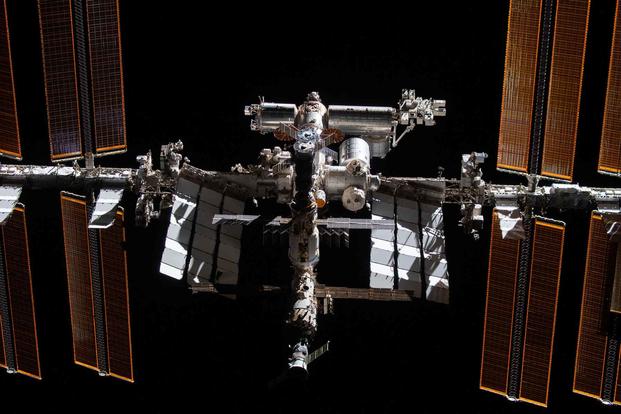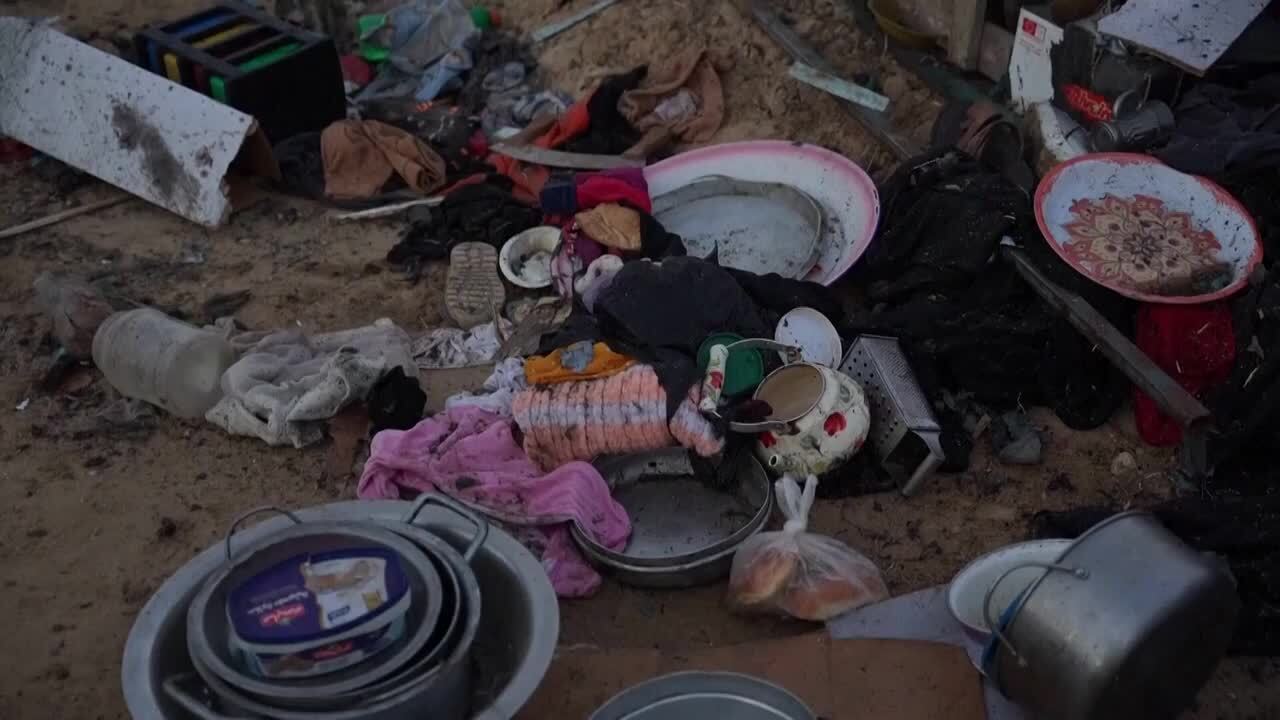Trapped on a collision course, the U.S. astronauts assigned to the International Space Station weigh their options. Sheltered inside their Crew Dragon capsule, they have 15 minutes to figure out whether, in the event of a looming disaster, to abandon the sprawling orbital science lab and fly home.
The scenario isn’t from the plot of the new movie “I.S.S.,” the science-fiction thriller opening Jan. 19 that envisions U.S. astronauts and Russian cosmonauts in a battle for control of the space station. Instead, it describes a real dilemma that ISS crew members recently faced in an all-too-real emergency.
In November 2021, U.S. Air Force Col. Raja Chari was the spacecraft commander of a U.S. and German crew that had traveled together to the ISS when, without warning, a rocket fired from the ground destroyed a defunct Soviet satellite in orbit. Russia’s demonstration of its direct-ascent, anti-satellite weapon system (ASAT) left behind a massive orbiting debris field that almost immediately began to threaten the ISS in a series of near misses where their orbits intersected.
“Heads-up, 15 minutes to the next debris field pass,” a voice from Mission Control warns Chari and his crewmates as they waited in the Crew Dragon, according to an audio clip released by NASA and posted to YouTube.
“Copy. Is the conjunction still a yellow risk, or has it changed?” asks Chari, an Air Force test pilot on his first space mission.
“It’s an equivalent yellow for the next debris pass, and also we are estimating that the probability of a hit to Dragon would be lower than the rest of ISS.” Translation: The Dragon capsule was likely safer than waiting inside the space station.
Like in the movie, 2021’s emergency involved a brush with Russia’s war machine (although Russian officials reportedly disputed at the time that the station was ever in any danger). In “I.S.S.,” the threat is more acute: U.S. and Russian crews have opposing orders to take over the space platform “by any means necessary.” The conflict doesn’t just threaten the crews, but to deorbit the station in a spectacular fashion.
Back in the real world, however, even if the U.S.-Russia partnership holds up over the next 4-6 years of the station’s planned use, other factors keep adding to the likelihood that some kind of emergency will happen up there that sets off a similarly disastrous chain of events. After all, significant uncertainty is inherent in preventing the giant research station, traveling at 17,500 mph, from falling chaotically out of the sky.
Related: NASA Eyes Billion-Dollar Space Vehicle to Avert International Space Station’s Uncontrolled Reentry
While you wait for “I.S.S.” to drop at your local theater, here are some of the things that could go wrong with the aging space station in real life:

1. An Aging Part, or Even a Newer One, Malfunctions
NASA took the opportunity in December to celebrate the ISS’s 25th birthday and to mark the program’s achievements. At the same time, the observance signaled that the station was nearly four years past its originally planned decommissioning, and its service life had recently been extended once again.
The most likely emergency scenarios that the ISS crews train for include “fire, depressurization and atmospheric contamination,” a NASA spokesperson told Military.com. In the event of an emergency, the crew’s safety would come first, followed by the space station’s. “Teams on Earth continually assess hazards and concerns, as well as update training and response plans as appropriate,” the spokesperson said.
Still, cracks have started to emerge in the ISS -- literally.
Unless a three-plus-year-old problem has resolved since the fall, Russia’s Zvezda service module -- which went into service in 2000 and harbors some of the station’s most critical systems, including life support, flight control and propulsion, among others -- is likely leaking air from “various cracks in the module’s structural shell” that “remain elusive,” though some had been found and fixed, according to the October 2023 quarterly report by NASA’s Aerospace Safety Advisory Panel. Meanwhile, a series of coolant leaks emerged in 2022 and 2023 from various other ISS components.
An official with Russia’s Roscosmos space agency said one of the coolant leaks could have come from a micrometeorite collision, highlighting another emergency scenario:
2. A Collision, Ever Likelier, Damages Critical Hardware or a Transport Vehicle
The approximately 1,700 sizable pieces of debris from Russia’s ASAT demonstration hadn’t yet diverged far into all their different trajectories when the Air Force’s Chari posed to NASA’s Mission Control Center the idea of his crew flying home. He might have imagined colliding with more than one of the chunks still orbiting in a relative clump at the time. Satellites can also break apart without being struck by a projectile, like one that separated into about 85 pieces in January 2023.
The Space Force’s 18th Space Defense Squadron was tracking more than 43,000 objects larger than 10 centimeters in Earth orbit as of December 2022, including both satellites and debris, according to a report by Rand Corp. A million more objects from 1-10 cm in size were estimated to also be in orbit.
The space station crews had to maneuver out of the way of possible debris collisions five times in 2023, a NASA spokesperson told Military.com. That’s the most of any year in ISS history except 2014, also with five. The average, including 2023, is about 1.3 collision avoidance maneuvers per year, according to data from NASA’s Orbital Debris Quarterly News.
As more new satellites continue to occupy low Earth orbit, the altitude band that’s home to the ISS, the likelihood goes up of satellites colliding or breaking up to create even more debris. With the advent of mega-constellations, such as SpaceX’s Starlink satellite internet, and plans for hundreds more like it being conceived around the world -- not to mention more modestly sized ventures such as the Space Force’s Proliferated Warfighter Space Architecture -- projections range so widely as to how many satellites will inhabit this area in the coming years that they don’t seem safe to cite.

3. War on the Ground Really Does Play Out in Space
We’ll leave it to the filmmakers behind “I.S.S.” to speculate on the physics of fighting face to face, or from the opposite sides of a locked hatch, while weightless inside (not to mention outside) a series of cramped, cluttered tubes -- or why the ISS even rates as a military asset at all.
In reality, if the Russian government simply decided to exit the ISS partnership, that could prove sufficiently problematic since the systems that steer the station reside on the Russian side, including “all of the propulsion … for station [altitude] reboost, attitude control, debris avoidance maneuvers and eventual de-orbit operations,” according to NASA.
But anything short of a hot war seems unlikely to precipitate an orbital confrontation. Even with the U.S. and Russia currently oriented on opposite sides of the war in Ukraine, the two countries’ ISS programs continued to work, as of the October report of the safety board, “in a highly professional and productive manner, in keeping with the long history of cooperation and mutual support in human space flight.”
Meanwhile, the countries have reportedly extended to 2025 their agreement to fly astronauts to the ISS on each other’s spacecraft, Russia’s Soyuz and SpaceX’s Crew Dragon. While four of the five partners have agreed to extend ISS operations until 2030, Russia has committed to go only until 2028, according to NASA.
A NASA spokesperson never replied directly to a query by Military.com about whether, or to what extent, in the absence of the Russians, NASA astronauts could control the space station. But the agency acknowledges on its website:
“NASA and Roscosmos crew members are not trained to operate each other’s respective segments without onboard assistance. In failure scenarios on the United States Orbital Segment, only U.S. astronauts are trained to fully respond. … The same is true for Russian cosmonauts in failure situations originating on the Russian segment.”
4. Any One of These Risks Ends in a Chaotic Reentry
Nothing like the space station has ever existed -- at least as far as we know -- so, as NASA puts it, the ISS presents “physics and engineering challenges when it comes to re-entry modeling.” For now, NASA doesn’t think the five international ISS partners have what’s needed to safely deorbit the ISS, either in an emergency or when its mission has ended.
By “safely,” the agency means it hopes to prevent falling debris from landing on any populated areas; and that what’s left of the space station, after parts of it burn up in the atmosphere, will crash into the ocean.
In addition to potentially endangering people and infrastructure on the ground, the space station -- adrift in the wake of an emergency, its orbit starting to decay -- could pose a safety consideration for any satellite operators with things orbiting at lower altitudes.
Once the space station reaches the atmosphere, engineers expect solar arrays and radiators to break off first, followed by the pressurized modules where astronauts reside and experiments take place, “and finally individual module fragmentation and loss of structural integrity of the truss,” or structural backbone, according to NASA. Much hardware, the agency says, will melt or vaporize, “whereas some denser or heat-resistant components like truss sections will survive re-entry.”
NASA announced its idea in 2023 to acquire a one-of-a-kind space vehicle to propel the ISS into a certain position during the deorbiting process to try to facilitate a safe descent.
In the meantime, none of 2023’s five close calls required the crews to take shelter inside either the space station or the capsules waiting to fly them home, NASA told Military.com. And back in 2021, none of the debris from the ASAT test ultimately struck the ISS that day. However, if future crews, sheltered inside their transport capsules, suit up in their spacesuits and fly home without a deorbiting solution in place, the world may not be so lucky.
Keep Up With the Best in Military Entertainment
Whether you're looking for news and entertainment, thinking of joining the military or keeping up with military life and benefits, Military.com has you covered. Subscribe to the Military.com newsletter to have military news, updates and resources delivered straight to your inbox.

















